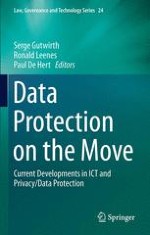2016 | OriginalPaper | Chapter
On Locational Privacy in the Absence of Anonymous Payments
Authors : Tilman Frosch, Sven Schäge, Martin Goll, Thorsten Holz
Published in: Data Protection on the Move
Publisher: Springer Netherlands
Activate our intelligent search to find suitable subject content or patents.
Select sections of text to find matching patents with Artificial Intelligence. powered by
Select sections of text to find additional relevant content using AI-assisted search. powered by
